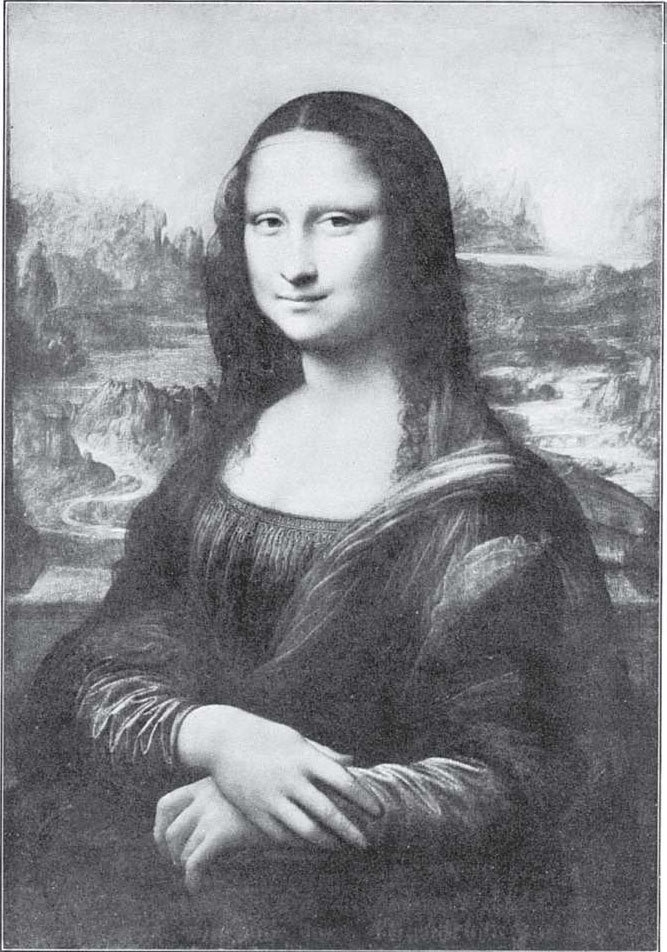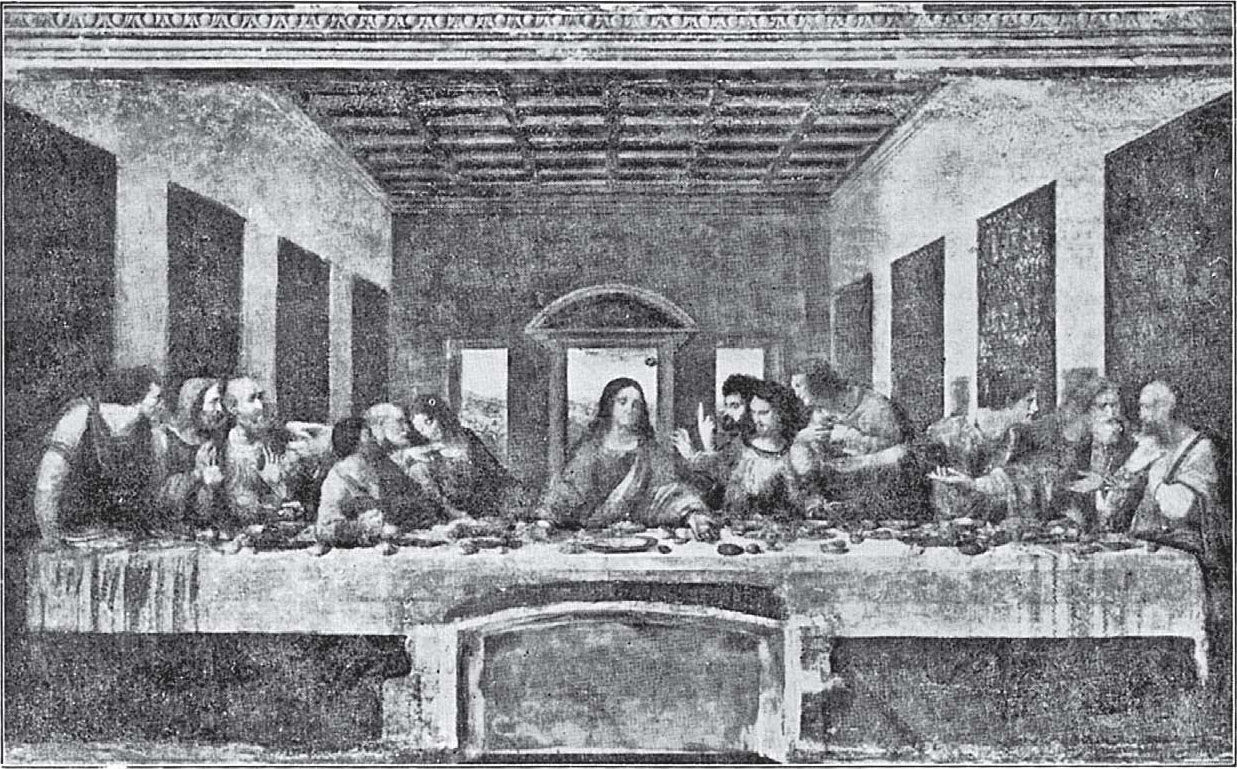





P UT this line in front of a mirror and then you can read it quite easily.

That is what people found they had to do with notes written by a very great man named Leonardo da Vinci (Layo-nar’doe dah Vin’chee). It is not because he wrote from right to left across the paper, that we call him a very great man,though! It is because he knew how to do more things well than any one else in the whole world. Probably he wrote from right to left because he was left-handed.
Leonardo da Vinci lived during the Renaissance, in Italy.He was born some years before the painter Raphael, and was still alive many years after Raphael died. Among the many and varied things Leonardo da Vinci did well was painting. Some people still think he was the best painter that has ever lived.And yet he was interested in doing so many other things besides painting, that he painted only a few pictures in his long life.
One of Leonardo’s paintings is in the Louvre, an art gallery in Paris. The picture is called “Mona Lisa” (Mo’nah Lee’sah).Some years ago this famous picture was stolen right from the wall of the Louvre and newspapers all over the world printed the story with just as big head-lines as if a great king had died or a big ship had been sunk at sea. Luckily, it was found finally and put back in the Louvre, though the real thieves were never caught.
The “Mona Lisa” is the picture of an Italian lady. On her face is a faint smile. If the artist had changed the painting the least bit, there might have been no smile there at all. It is a puzzling smile. Mona Lisa seems to be smiling at something that no one else knows anything about.
There are other things to notice besides the smile. Notice how solid the woman seems — not flat like a cardboard woman, but as if she were a real person. Leonardo could make her look real because he understood how to use dark and light, how to make the bright part fade into the shadows.He was the first painter to understand how to do this.

NO.13-1 MONA LISA

Next notice the background, the part of the picture behind the woman. It is a landscape, with a stream and hills and mountains. When you look at a real landscape, you know you can’t see things far away quite as clearly as things close to you. That is because of all the air between you and the things that are far away. Although you can’t see this air,you can understand that the more air you look through, the dimmer things seem. Leonardo da Vinci was a great enough painter to make the landscape look as if it really were far away. He was the first painter who understood how to do this, too.
Another painting by Leonardo is not in an art gallery,where it would he carefully taken care of, but is in a low,damp room in a monastery in Italy where it has been badly damaged by moisture. It is one of the world’s greatest paintings, but it will never be put in an art gallery, because Leonardo painted it directly on the wall.
The picture is known as “The Last Supper.” It shows Christ and the twelve Apostles seated at a long table. Leonardo chose to picture the moment when Christ has just said, “One of you will betray me!”
Can you not imagine how absolutely terrible to these Apostles would be the thought of betraying their beloved Master, whom they knew as the Son of God? Leonardo shows by their gestures, their hands, the expression of their faces, how each Apostle feels when he hears these words.
To show what men in a painting feel is not easy. A painter cannot, of course, make the people in his pictures speak what they feel. If he wants to show their feelings, he must do it by showing how people look when they are thinking a certain thing. Leonardo visited deaf and dumb people, to learn how they showed their feelings when they were excited or happy or frightened or angry. This helped him make the people in his pictures show just the feelings he wanted them to — even if they could not speak.

NO.13-2 THE LAST SUPPER DA VINCI
Not many years after “The Last Supper” was painted,the paint began to come off the plaster of the wall. One reason for this was that Leonardo painted on the dry plaster.Michelangelo and other wall painters always had painted on the plaster when it was still fresh and damp. When they did this, the paint sank into the fresh plaster and couldn’t peel off unless the plaster came off, too. You remember I told you this kind of painting is called fresco, which is the Italian word for fresh. Leonardo was interested in trying new ways of painting, and so, unfortunately, he didn’t use the old-style fresco way for his “Last Supper.”
When the paint had flaked off in many places, other artists painted over the picture where they thought it needed touching up. After a time a great part of Leonardo’s painting was covered by the much poorer painting of these much poorer painters. Worst of all, the monks decided to cut a door in the wall. The top of the doorway was made right in the middle of the lower part of the painting, and of course the hammering to make a hole through the stone wall jarred off more of the paint.
Later, Napoleon led his armies into Italy, and some of his soldiers used the room of “The Last Supper” as a stable for their horses! They even amused themselves by throwing their boots at the painting to see if they could hit Judas Iscariot,the Apostle who betrayed Jesus.
So year by year this wonderful painting became more and more a ruin, until there was danger that it would be lost altogether. Finally, a wise Italian found a way of making what was left cling to the wall so it would not come off.Then he managed to take off all the paint put on by the other painters, so that now the picture is in better condition than it has been for hundreds of years.
We have only about three or four other paintings by the great Leonardo da Vinci. One that every one likes is called“The Virgin of the Rocks.” It shows the baby Jesus and His mother seated on the ground with the little Saint John and an angel. They seem to be in a place of caves and dark rocks.Through openings in the rocks we can see the bright blue of a waterfall and the green of plants.
Leonardo knew more about plants and flowers than any one else of his time. One of the paintings of a follower of his named Luini (Loo-ee’nee) is named for a flower. It shows a young woman holding a columbine and so this painting is called “The Columbine.” Luini’s women have the same kind of half-smile that Leonardo painted so well. Luini was a good painter, but not nearly so good as Leonardo da Vinci,the wonderful genius whom he imitated.